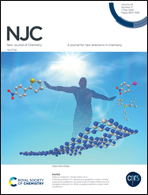One step microwave-hydrothermal synthesis of rGO–TiO2 nanocomposites for enhanced electrochemical oxygen evolution reaction†
Abstract
The present work reports the one-step synthesis of reduced graphene oxide (rGO)–TiO2 nanocomposites using a microwave-assisted hydrothermal method. The well-dispersed TiO2 nanoparticles on rGO sheets were obtained without a reducing agent. X-ray diffraction, Raman and infrared spectroscopies indicated the reduction of graphene oxide (GO) under microwave conditions, and the microscopy images revealed the successful formation of nanocomposites. In addition, double band gap values (Egap = 2.39 and 3.37 eV) for the 16rGO–TiO2 nanocomposite were observed. The heterostructure presented a higher electrocatalytic performance for water oxidation under neutral and alkaline conditions, when compared to pure TiO2 nanoparticles, and long-term current stability. The electrochemical characterization showed that the rGO–TiO2 nanocomposites presented efficient charge separation, as demonstrated by photoluminescence spectra, which was related to the high electronic transfer between TiO2 nanoparticles and rGO sheets. This work provided new insights into the development of high performance and cost-effective rGO–TiO2 electrocatalysts for the oxygen evolution reaction.



 Please wait while we load your content...
Please wait while we load your content...